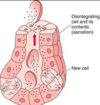5 - Glands Introduction Flashcards
What is a gland?

What is a secretion?

What are the three types of secretion from glands?
(cytocrine is when whole alive cell is secretion like sperm)
(remember if cell membrane is transiently larger or smaller)

What is transepithelial transport?
- Material endocytosed at one side of epithelia
- Vesicle shuttles through cytoplasm
- Exocytosis on opposite surface
(For molecules too large to penetrate membranes)

What is a unicellular exocrine gland?
Goblet cell

Where are goblet cells found?

How is mucus made?
Water mixes with glycoprotein mucin, released from goblet cells, to make mucus
What is an endocrine gland?
- A gland that secretes directly into the blood
- Secretion acts at distant parts of the body.
- Secretions are hormones
- All cells secrete the hormones in the gland
- Ductless
e.g pituitary gland
What is an exocrine gland?
- Secrete into region of the body through a duct
- Secretions on surface of cell
- Only cells at the apex of the duct secrete
- Secretions are enzymes and lubricants
e. g salivary, sebaceous, sweat, pancreas, mammary, lachrymal

What is a unicellular endocrine gland?
Diffuse neuroendocrine system
(can be isolated in areas like lungs or multi cellular such as islets of langerhans)
What is the structure of the pituitary gland and what does it secrete?

What is the point of sebaceous and lachrymal glands?
- Produce sebum to protect from pathogens, e.g ear wax
- Moisten eye and produce lysozymes to attack bacteria
How is an exocrine gland formed?
Cannicularisation (apoptosis of central cells)

How is an endocrine gland formed?

Why are thyroid folliles spherical?
Colloid produced and put in between epithelial cells causing them to expand into a sphere
What are different shapes of exocrine gland and some examples of the type of glands in each category?

What are myoepithelial cells?
Epithelial cells containing actin and myosin, they help to extract secretions from cells into duct

What are the different duct names in a exocrine gland?

How can you tell the difference between serous and mucous glands histologically?
Serous:
- Stain darker due to zymogen granules
- Rounded nuclei towards base
Mucus:
- Stain pale due to mucous
- Flattened nuceli towards basement membrane

What are the two types of merocrine secretion?
Constitutive - Secretory product not concentrated into granules, packaged and continously released from surface. Used to repopulate membrane
Regulated - Secretory granules accumlate in large vesicles and are release by exocytosis when stimulated, need influx of Ca ions. Active and contains modified proteins, e.g insulin secretion

What happens during secretion at mammary glands?
Neonatal: Only fats secreted by apocrine. Proteins secreted by merocrine
Lactation (8 days after birth): Fats and proteins released by aprocrine
What happens during secretion in a sebaceous gland?
- Holocrine
- Cells fills with secretory granules
- Cell organelles degenerate
- Cells die
- Plasma membrane breaks and contents empty
- Dead cells replaced by mitosis of basal layer

What is the role of the golgi in secretion?
- Glycosylate lipids and proteins
- Transport through cisternae
- Package proteins and lipids and decide their destination

What is glycosylation and what is the role of it?
The covalent attachement of sugars to lipids or proteins by enzymes

- Aid protein folding
- Prevent protein and lipid digestion
- Cell recognition (blood groups)
- Adhesion to substrates and neighbouring cells




